




Review by Kevin Steele, August, 2003
Overview
When choosing components for a MAME arcade cabinet, one of the most important choices is the type of display. Quite often if you manage to find an old arcade cabinet you’ll get an arcade monitor included with the cab. In this case, the choice of display has already been made.
In other situations, however, you’ll need to choose between a genuine arcade monitor, a TV, or a computer monitor. While an arcade monitor is usually provides the most “arcade-perfect” picture, setting one up for MAME use has generally been more difficult than using a TV or a PC monitor, and the picture quality in Windows applications has been poor.
The Wells-Gardner D9200 arcade monitor is a unique “all-in-one” solution to this dilemma. A “hybrid” monitor, it shares the characteristics of both an arcade and a PC monitor. Capable of displaying nearly all arcade display modes, it is also capable of displaying standard CGA, EGA, VGA, and (unofficially) SVGA PC modes.

The Wells-Gardner D9200 Arcade Monitor
Available in both 27" and 33" sizes, the D9200 is an enormous beast of a display. The model I ordered was the "27 Inch D9200 Digital Monitor - Universal (15/25/31 KHZ), model WGM2792-U0TS42A."
The display weighs over 80 lbs., and that’s without any sort of cabinet or housing. In the box it requires a hand-truck to move around.
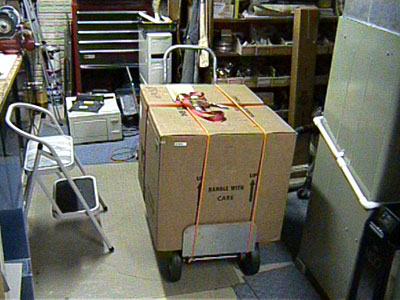
The Box It Comes In
The D9200 is designed to be PC-ready right out of the box. Instead of having to wire-up a custom cable to connect the monitor to a PC, the D9200 comes with a DB15 video connector, a VGA video cable, and even a standard power cord. It is truly ready for “plug-and-go” MAME use. Here are the official specs from the Wells-Gardner web site.
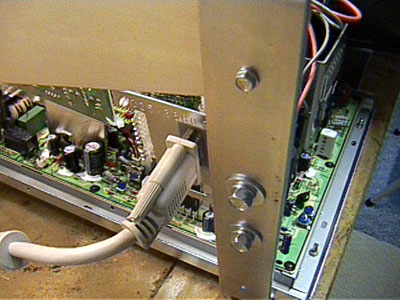
VGA Cable Connection
First Impressions
The D9200 basically resembles a large television stripped of its housing. It’s nothing more than a huge picture tube, some circuit boards, and a mounting frame. In fact, there’s precious little else included in the box: you get the D9200, a schematic sheet, a power cable, and a VGA cable. Of course, since the D9200 is designed for mounting in an arcade cabinet, anything else is just fluff — the D9200 has everything necessary.
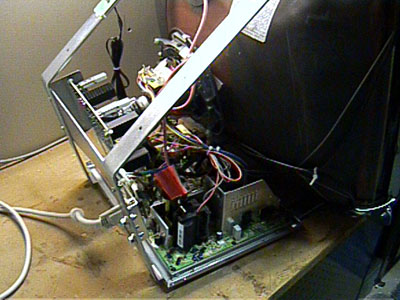
Back View of the D9200
The first impression you’ll get of the D9200 is a hernia, especially if you try to lift it by yourself. At 80 lbs. it’s not impossible to lift, but the large, bulky shape and size makes it extremely awkward to handle. (That, and the fact that if you touch the wrong wire you stand the risk of giving yourself a severely nasty shock, even if the monitor is unplugged!)
In addition to being heavy, the D9200 is large, as well: 24" wide, 22" high, and 20" deep. It features a 28.5" tube, with a 27" display area.
The D9200 is more like a PC monitor in some ways than an arcade monitor — it even includes a small “control panel” to adjust the screen settings for each resolution. The control panel is attached to one of the frame bars, but it has a long cable and can easily be relocated to the front of your cab, if you wish.
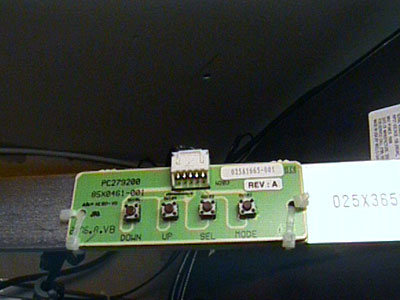
Monitor Adjustment Buttons
The control panel works like most monitor control panels, with a Mode button, a Select button, and Up and Down buttons. Using the buttons you can adjust the brightness, contrast, horizontal and vertical size and position, color, and screen geometry (pincushion and trapezoid). While the controls are generally a bit sparse compared to most modern-day PC monitors, this is still a quantum step above what you'll find with a normal arcade monitor.
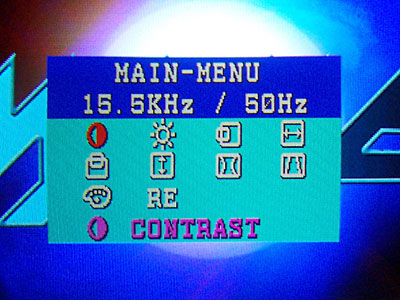
The On-Screen Adjustment Menu
One of the advantages of having a monitor without a housing is that you have easy access to all of the internal adjustments as well. In addition to all of the on-screen monitor adjustments, you can access the main circuit board to adjust the screen rotation and focus.
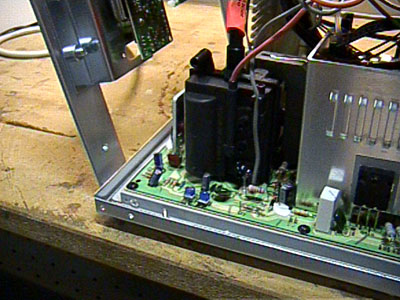
Additional Picture Adjustment Pots
Unfortunately, not all the monitor adjustments I would have liked to have had were available on the D9200, especially since the monitor I received had some convergence problems, and there was no way to correct this problem (more on this in the next section!)
Next > |
